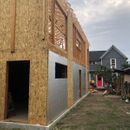Is this an effective air sealing strategy?
I’m in the middle of construction on a two story 1200 SF building with 1 car garage and office on ground floor, and 600 SF apartment on second floor. Construction is 2×6 on 24″ centers, with 4″ continuous EPS insulation on exterior walls. Roughly R-40 walls, R-60 roof, R-20 under slab and surrounding footing. Planning net zero energy w/ 3000 W solar array.
Due to the high cost of OSB ($64/sheet when I bought materials), I used intermittent bracing for the long walls, and used 7/16″ polyiso to bring the rest of the wall into plane for the EPS layers (see attached photo). Originally I planned airtight drywall for the air barrier, but now I’m thinking the polyiso/OSB sheathing layer might be the best choice. I’ll tape all seams with Blueskin and run a bead of spray foam where the OSB and polyiso attach to the studs and plates.
Is this an effective strategy? If I go this route, any suggestions for how to tie into ceiling air barriers on first and second floors?
GBA Detail Library
A collection of one thousand construction details organized by climate and house part










Replies
David,
I'll give you a bump and note that you should still use the airtight drywall approach regardless.
> a bead of spray foam
IMO, canned spray foam is a long-term unreliable air seal. But it won't hurt where tape or Blueskin is the primary air seal.
For a given ACH, warm side air barriers provide better moisture performance.
Thanks for the bump, Steve. Why would you favor the airtight drywall approach? How forgiving is installation of airtight drywall?
So, if I understand correctly, a potential problem with the air barrier I'm considering is moist air moves from the building interior and through the fluffy insulation. I assumed 4" of foam on the outside of the OSB/Polyiso layer would keep it warm enough to prevent condensation, but I see why keeping moisture out of the wall with the air barrier at the drywall would be preferable.
Blueskin tape doesn't stick all that well unless you use a primer. Better choice is one of the many acrylic tapes for this (ZIP or 3M8067). Sealing up the sheathing, even if you are using foam panels for some areas, is always the best air barrier as there are many fewer transition and holes in it. Make sure to tape your sheathing to the foundation as well, some tapes require a primer over concrete.
The simple way to seal the sheathing to the floor and the ceiling requires a bit of planning as you build since you need a sheet good or wide tape to go from the sheathing to the inside, harder to do after built.
Since the structure is already built, the simplest is one of the smaller 2 part spray foam kits. You can seal up the rim joist area before the drywall goes in and the ceiling drywall to top plate/outside sheathing after the ceiling is installed and before the attic insulation goes in. The SPF is also a good way to seal up any of the interior wall top plates and any light fixtures while up there.
With the sheathing sealed up interior air tight drywall is not so critical but it still doesn't hurt to take a bit of care. I like to caulk behind the drywall around the perimeter/rough openings and use vapor tight device boxes (plastic ones with a foam gasketed flange) in exterior walls.